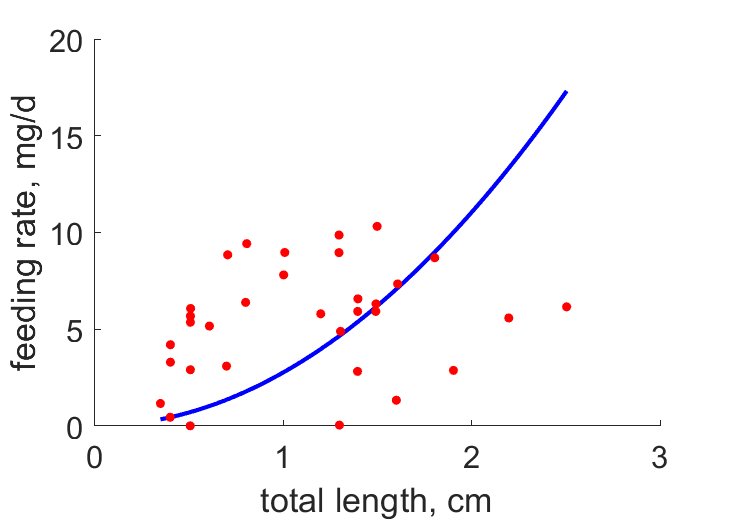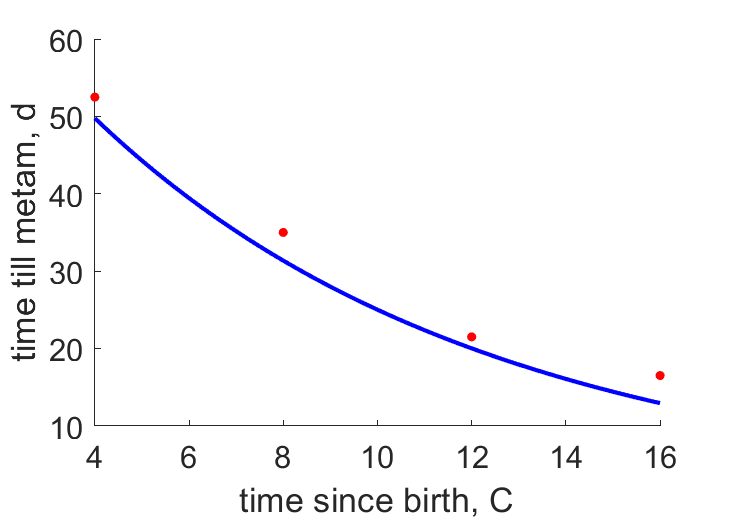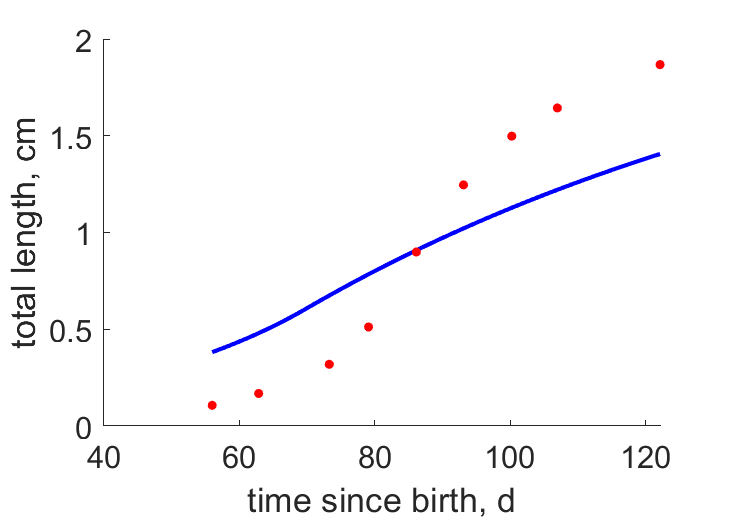Predictions & Data for this entry
| Model: abj | climate: MC | migrate: | phylum: |
| COMPLETE = 2.5 | ecozone: MANE | food: bjPz, jiCih | class: |
| MRE = 0.119 | habitat: 0jMp, jiMb | gender: Hh | order: |
| SMSE = 0.082 | embryo: Mp | reprod: O | family: |
Zero-variate data
| Data | Observed | Predicted | (RE) | Unit | Description | Reference |
|---|---|---|---|---|---|---|
| ab | 20 | 20.01 | (0.0006447) | d | age at birth | Rive1978 |
| tj | 80 | 70 | (0.125) | d | time since birth at puberty | Foli1993 |
| tp | 90 | 93.75 | (0.04172) | d | time since birth at puberty | guess |
| am | 125 | 124.9 | (0.000743) | d | life span | Foli1993 |
| Lj | 0.5 | 0.6084 | (0.2169) | cm | total length at metam | Foli1993 |
| Lp | 1 | 1.031 | (0.03099) | cm | total length at puberty | Foli1993 |
| Li | 2.3 | 2.379 | (0.03442) | cm | ultimate total length | Foli1993 |
| Wwb | 2.145e-06 | 2.135e-06 | (0.004636) | g | wet weight at birth | Rive1978 |
| Wwi | 0.14 | 0.1421 | (0.01503) | g | ultimate wet weight | guess |
| Ri | 256 | 254.6 | (0.005603) | #/d | maximum reprod rate | Chri1977 |
Uni- and bivariate data
| Data | Figure | Independent variable | Dependent variable | (RE) | Reference |
|---|---|---|---|---|---|
| LJX |  | total length | feeding rate | (0.7041) | Foli1993 |
| Tab |  | time since birth | time till metam | (0.09105) | Rive1978 |
| tL |  | time since birth | total length | (0.3278) | Foli1993 |
Pseudo-data at Tref = 20°C
| Data | Generalised animal | Cuthona nana | Unit | Description |
|---|---|---|---|---|
| v | 0.02 | 0.002531 | cm/d | energy conductance |
| kap | 0.8 | 0.7196 | - | allocation fraction to soma |
| kap_R | 0.95 | 0.475 | - | reproduction efficiency |
| p_M | 18 | 1716 | J/d.cm^3 | vol-spec som maint |
| k_J | 0.002 | 0.002 | 1/d | maturity maint rate coefficient |
| kap_G | 0.8 | 0.8003 | - | growth efficiency |
Facts
- Feeds on hydroid Hydractinia echinata (0.018 mg/ polyp) large individuals eat polyps, small ones mat material (stolons) (Ref: Wiki)
- max length at Gerrish Island 1.2 cm, Gosport Harbor 2.3 cm (Ref: Wiki)
- survives 16 C with 2 water refreshments/d (Ref: Rive1978)
- up to 16 egg masses in lab of 300-600 eggs, first and last smaller. Veliger larva do not swim freely and metaphose wihtin 1 or 2 d (Ref: Rive1978)
- Adult specimens of C. nana kept without food in Millipore-filtered sea water continued to lay egg masses for up to ten days. The size and activity of the adults progressively diminished during that time, but some starved individuals survived for 17 days. They laid several egg masses in the first few days of isolation, but the frequency of oviposition and the number of eggs per spawn decreased with time. Mean egg diameter did not vary, and the rate and events of larval development and metamorphosis proceeded normally in the presence or absence of H. echinata. (Ref: Rive1978)
- hermaphrodite (Ref: Wiki)
Bibliography